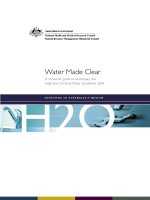A Practical Guide to Particle Counting for Drinking Water Treatment - Chapter 17 pdf
Bạn đang xem bản rút gọn của tài liệu. Xem và tải ngay bản đầy đủ của tài liệu tại đây (70.93 KB, 2 trang )
151
CHAPTER
17
Particle Counter Electronics
The particle counters manufactured for drinking water all employ laser driver
and detector circuits that are similar in purpose. The details of these circuits are not
made available to the public, and any significant discussion of them would be beyond
the scope of this book. The counting electronics and power supplies provided will
be discussed briefly.
A. COUNTING ELECTRONICS
1. Met One
The Met One PCX employs a 12-bit PHA counting circuit. Up to 4096 count
channels are theoretically possible. Eight channels are standard, while up to 32 are
available for online use. These size ranges are set through the digital interface with
the manufacturers’ software. For best sizing accuracy, the upper size range should
be set at or below 20 µm. This allows all 4096 channels to cover the 0 to 1 V range.
If a larger upper value is used, these channels are spread out over 10 V (up to 750
µm). This reduces the sizing accuracy by an order of magnitude.
For most applications, the 20 µm upper limit is sufficient. This mode should
certainly be used if resolution and count correlation between instruments is important.
The PHA card is used to calibrate the Met One sensor. All 4096 channels may
be downloaded to provide a histogram of particle sizes. This allows each particle
counter to be calibrated in the field.
The Met One model PCT analog output particle counter, along with the older
model 215W and model 203 units, employ voltage comparator counting circuits.
Each has only two size channels, which provide only total counts. Unlike the PCX,
these channels are cumulative only, except for the version of the PCT that does not
have a local display. That unit provides a jumper setting that allows the first channel
to be set to a differential mode. The size thresholds on all of these units are set
manually with trimpots. Although they may be adjusted by the user, they are not
L1306/frame/pt03 Page 151 Friday, June 23, 2000 2:15 PM
© 2001 by CRC Press LLC
152 A PRACTICAL GUIDE TO PARTICLE COUNTING
designed to be adjusted routinely. The factory should be consulted before changes
are attempted.
2. Chemtrac
The 2400D counting electronics are built around a 16-bit PHA card. Only eight
size channels are supported by the software, but 64,000 are theoretically possible.
Once initialized, the 2400D is designed to run independently of any external control,
and provides sample updates once a minute. Calibration information is stored in
memory in the sensor. Size ranges are set with software.
The 2400D was initially intended to size particles up to the 1000 µm, but the
circuitry to provide this was not implemented. To maintain better resolution of the
smaller particles, the effective size range is from 2 to around 70 µm. This is more
than enough for drinking water treatment applications.
The 2400D counting electronics is not used for calibration purposes. It is cur-
rently limited to a maximum of 16 size channels in the version configured for the
grab sampler.
3. ARTI and IBR
ARTI and IBR particle counters both employ comparator-type counting elec-
tronics. Each provides eight size channels. The size thresholds are set via the digital
interface.
B. POWER SUPPLY
All of the units use the newer switching power supplies that provide higher
efficiency and will operate over a wide input range. Met One and IBR mount the
AC supplies separately from the main enclosure to prevent hazards from sample
leakage. ARTI and Chemtrac keep the sample path isolated from the main enclosure,
allowing the power supplies to be mounted integrally.
L1306/frame/pt03 Page 152 Friday, June 23, 2000 2:15 PM
© 2001 by CRC Press LLC






![the game audio tutorial [electronic resource] a practical guide to sound and music for interactive games](https://media.store123doc.com/images/document/14/y/oo/medium_oon1401475551.jpg)


